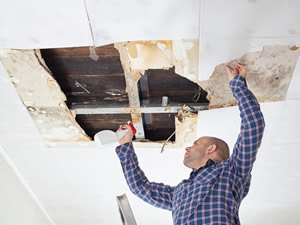A Review Course on Indoor Air Quality
- By Michael Fickes
- 10/01/17

PHOTO © VOLKOVSLAVA
What happened to that great history course you offered last year? Semester after semester, your students have always been fascinated by the lectures in that course. This year, though, students and lecturers alike are coughing and sniffling. Many are also yawning and laboring to stay awake. What’s going on?
Students typically feel sick or sleepy in class because they didn’t get enough sleep the night before. This young man stayed up to watch Jimmy Fallon with his roommates last night. That young woman is on her own for the first time, and she is having a blast — until all hours of the night. That’s what young people do when they get to college.
Then again, there are other explanations for classroom fatigue. It might be that the air inside the dormitories and classroom buildings is dirty. In technical terms, the problem might be poor indoor air quality, or IAQ.
The air in the classroom is putting people to sleep? How could that happen? The answer sounds more like horror fiction than science. But it has been scientifically proven that in buildings that seem to make occupants tired or ill there are tiny invisible particles, unaffected by gravity, floating in the air. Building occupants breathe that air and take the particles into their lungs. The impurities adversely affect their breathing and wakefulness.
Tiny, Invisible Particles?
Tiny invisible particles? Come on. Yes. As it turns out, virtually everything inside a room emits tiny, invisible particles. Emitters include the materials used to construct the building; the furnishings, such as the desks, blackboards and even the chalk (or the whiteboards and markers) — all are contaminating the air with emitted particles.
And there’s more. When the occupants of a room move around, they stir up these particles and send them into the air, making them easier to breathe in. Occupants also add more particles to the air — as they move around, their clothing, bodies and hair shed particles.
Particle shedding by objects and by people is called off-gassing, and breathing in off-gasses causes people to grow fatigued.
Anyone who has painted a room knows about off-gassing. It takes a couple days for the off-gas paint smell to go away. Unfortunately, what most of us never knew is that off-gassing is continuous. It never stops, and we cannot tell that it is there.
“While the odor may go away, off-gassing does not stop,” says Nick Agopian, vice president, sales and marketing, with RenewAire, LLC, a Soler Palau company. “Off-gassing contaminants are generated internally by the construction materials used to build the building as well as by the furnishings in the building.”

PHOTO © LIGHTPOET
Furnishings include desks, chairs, curtains… all of the elements that fill out the interior of a building.
“Even more important are the occupants of the building and the activities they engage in,” continues Agopian. “For example, when people get up in the morning, they shower, shampoo and condition their hair. Most of the men shave. By the time they are finished, they have over 80 different chemicals on their bodies, all of them off-gassing. In addition, their clothing off gasses — from the materials themselves as well as from the detergents and fabric softeners used to launder the clothing.”
According to the University of Colorado Environmental Center, additional sources of off-gassing particles include mold and mildew, poorly maintained HVAC systems, chemical cleaners, non-HEPA vacuum cleaners, smoking in and near buildings, vehicle exhaust entering buildings and laboratory chemicals.
Humidity or moisture in indoor air exacerbates existing IAQ problems. It facilitates both the growth and spread of mold and mildew and the off-gassing of the structural components of a building.
How do you detect these problems? “In many cases, you can detect mold and mildew with your nose,” says Kevin Brown, vice president and director of technical solutions with Canonsburg, PA-based ABM Franchising Group, LLC. “If you become aware of a musty smell when you first enter a space, there is probably a problem.”
The Fix: Dry Out the Air
“Mold is always present, but it needs three things to thrive and grow,” continues Brown. “It needs water, darkness or the absence of light and a food source like cellulose, perhaps in the form of the paper on the back of drywall panels.
If you do have a mold problem, you will need a plan to remediate it.
“Remediating IAQ involves dehumidifying the air and removing moisture within the space,” says Agopian. “By exchanging indoor air with outdoor air, we can reduce the steady state concentration of moisture-laden gases to acceptable levels.”
A mild problem can often be solved internally by opening windows or bringing in a dehumidifier.
If there is standing water, mold spots may become visible on various surfaces. In such a case, remediation is more complicated. “At that point, you will need to remove the three conditions that allow mold growth,” says Brown. “The first step is to remove water from the space.
“Next remove any other cellulose material, such as paper, books, carpet, furniture and so on. Furniture can be reused after a thorough cleaning — wiping down all surfaces with a soap solution.
“Foam cushions or cloth covered surfaces should probably be thrown out. While foam has no cellulose, cushions naturally collect dead skin cells, which are a food source for mold. I would also recommend wiping down the whole room, including light fixtures, walls and ceilings — everything that is accessible.”
Prevention
Once mold has been removed, the goal becomes preventing its return. Ventilation has proven to be an effective preventative measure.
Agopian points to research conducted by Amrin Rudd, a principal at AB SYSTEMS LLC in Annville, PA. “Amrin Rudd’s research showed that ventilation provided by an energy recovery ventilation (ERV) unit can achieve low concentrations of indoor contaminants.
“His research has been affirmed by the Institute of Medicine,” Agopian says. “Institute research showed that as the ventilation exchange rate increases, the concentration of gases and particulates declines.” The Institute of Medicine is part of the Washington, DC-based National Academies of Sciences, Engineering, and Medicine.
In addition to ventilating a space with an ERV, additional prevention measures include periodic visual inspections. “Look for potential sources of leaks,” says Pete Zuraw, vice president, market strategy and development with Guilford, CT-based Sightlines, a Gordian Company. “Inspect the outside of your building for potential leaks — holes in the roof, rotting wood, exposed and deteriorating ductwork.
On the inside of a building, you can measure temperatures, humidity and the levels of carbon dioxide and other gases. “Check for moisture in the walls or ceiling,” Zuraw continues. “In addition, inspect the mechanical systems, checking for the presence of water or pests. Are the mechanical systems operating properly? Is there any unusual activity — is the system operating longer than normal?”
Zuraw also suggests hiring a third party to inspect the building when it is operating properly. Such an inspection can then serve as an operational baseline against which to compare future inspections.
IAQ inspections should also be part of the recovery phase of a building’s emergency response plan. After a fire, destructive storm or other emergency, IAQ inspections rank as an important step in bringing a building back on line.
How are you doing this morning? How are your students, teachers and administrators doing? Are people having trouble staying awake? Are they coughing and sniffling more than normal? If so, check out your building’s indoor air quality. IAQ may be interfering with your institution’s ability to educate your students.
This article originally appeared in the issue of .